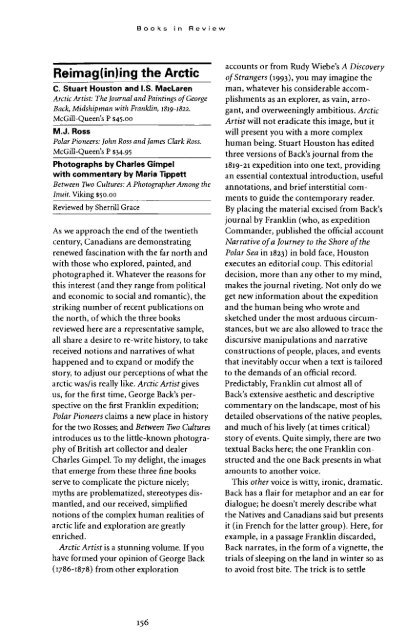Jean Rivard - University of British Columbia
Jean Rivard - University of British Columbia
Jean Rivard - University of British Columbia
You also want an ePaper? Increase the reach of your titles
YUMPU automatically turns print PDFs into web optimized ePapers that Google loves.
Books in Review<br />
Reimag(in)ing the Arctic<br />
C. Stuart Houston and I.S. MacLaren<br />
Arctic Artist: The Journal and Paintings <strong>of</strong> George<br />
Back, Midshipman with Franklin, 1819-1822.<br />
McGill-Queen's Ρ $45.00<br />
M.J. Ross<br />
Polar Pioneers: John Ross and James Clark Ross.<br />
McGill-Queen's Ρ $34.95<br />
Photographs by Charles Gimpel<br />
with commentary by Maria Tippett<br />
Between Two Cultures: A Photographer Among the<br />
Inuit. Viking $50.00<br />
Reviewed by Sherrill Grace<br />
As we approach the end <strong>of</strong> the twentieth<br />
century, Canadians are demonstrating<br />
renewed fascination with the far north and<br />
with those who explored, painted, and<br />
photographed it. Whatever the reasons for<br />
this interest (and they range from political<br />
and economic to social and romantic), the<br />
striking number <strong>of</strong> recent publications on<br />
the north, <strong>of</strong> which the three books<br />
reviewed here are a representative sample,<br />
all share a desire to re-write history, to take<br />
received notions and narratives <strong>of</strong> what<br />
happened and to expand or modify the<br />
story, to adjust our perceptions <strong>of</strong> what the<br />
arctic was/is really like. Arctic Artist gives<br />
us, for the first time, George Back's perspective<br />
on the first Franklin expedition;<br />
Polar Pioneers claims a new place in history<br />
for the two Rosses; and Between Two Cultures<br />
introduces us to the little-known photography<br />
<strong>of</strong> <strong>British</strong> art collector and dealer<br />
Charles Gimpel. To my delight, the images<br />
that emerge from these three fine books<br />
serve to complicate the picture nicely;<br />
myths are problematized, stereotypes dismantled,<br />
and our received, simplified<br />
notions <strong>of</strong> the complex human realities <strong>of</strong><br />
arctic life and exploration are greatly<br />
enriched.<br />
Arctic Artist is a stunning volume. If you<br />
have formed your opinion <strong>of</strong> George Back<br />
(1786-1878) from other exploration<br />
accounts or from Rudy Wiebe's A Discovery<br />
<strong>of</strong> Strangers (1993), you may imagine the<br />
man, whatever his considerable accomplishments<br />
as an explorer, as vain, arrogant,<br />
and overweeningly ambitious. Arctic<br />
Arfisf will not eradicate this image, but it<br />
will present you with a more complex<br />
human being. Stuart Houston has edited<br />
three versions <strong>of</strong> Back's journal from the<br />
1819-21 expedition into one text, providing<br />
an essential contextual introduction, useful<br />
annotations, and brief interstitial comments<br />
to guide the contemporary reader.<br />
By placing the material excised from Back's<br />
journal by Franklin (who, as expedition<br />
Commander, published the <strong>of</strong>ficial account<br />
Narrative <strong>of</strong> a Journey to the Shore <strong>of</strong> the<br />
Polar Sea in 1823) in bold face, Houston<br />
executes an editorial coup. This editorial<br />
decision, more than any other to my mind,<br />
makes the journal riveting. Not only do we<br />
get new information about the expedition<br />
and the human being who wrote and<br />
sketched under the most arduous circumstances,<br />
but we are also allowed to trace the<br />
discursive manipulations and narrative<br />
constructions <strong>of</strong> people, places, and events<br />
that inevitably occur when a text is tailored<br />
to the demands <strong>of</strong> an <strong>of</strong>ficial record.<br />
Predictably, Franklin cut almost all <strong>of</strong><br />
Back's extensive aesthetic and descriptive<br />
commentary on the landscape, most <strong>of</strong> his<br />
detailed observations <strong>of</strong> the native peoples,<br />
and much <strong>of</strong> his lively (at times critical)<br />
story <strong>of</strong> events. Quite simply, there are two<br />
textual Backs here; the one Franklin constructed<br />
and the one Back presents in what<br />
amounts to another voice.<br />
This other voice is witty, ironic, dramatic.<br />
Back has a flair for metaphor and an ear for<br />
dialogue; he doesn't merely describe what<br />
the Natives and Canadians said but presents<br />
it (in French for the latter group). Here, for<br />
example, in a passage Franklin discarded,<br />
Back narrates, in the form <strong>of</strong> a vignette, the<br />
trials <strong>of</strong> sleeping on the land in winter so as<br />
to avoid frost bite. The trick is to settle<br />
156

















